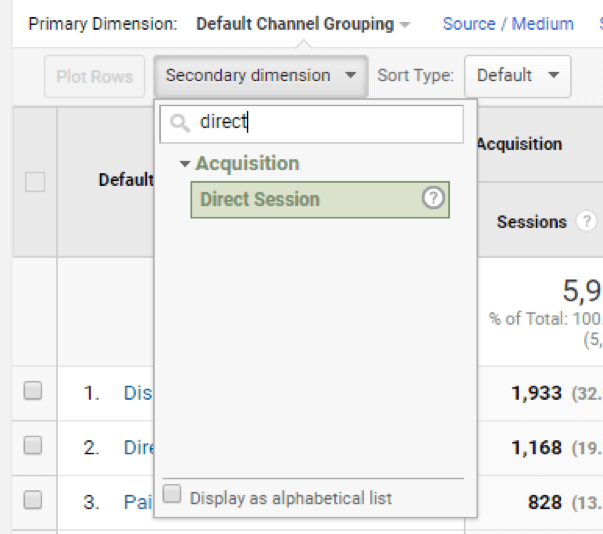Secondary Dimension in Google Analytics: Unlocking Advanced Metrics
Secondary Dimension in Google Analytics: Unlocking Advanced Metrics
Blog Article
Unlock Deeper Insights With Additional Measurement in Google Analytics
With the substantial stretch of information offered in Google Analytics, the application of additional dimensions can considerably improve your logical capabilities. By tactically including additional dimensions right into your analysis, you can discover important understandings that may or else continue to be obscure - Secondary Dimension in Google Analytics.
Understanding Main Vs. Additional Dimensions
When examining data in Google Analytics, it is vital to differentiate between additional and primary measurements to gain much deeper understandings right into customer behavior. Main dimensions are the primary groups through which you can view your data, such as touchdown, source/medium, or gadget page. These measurements supply the fundamental framework for arranging and recognizing your data. On the other hand, additional measurements permit you to additional dissect your main dimension data. By including a second measurement, you can layer on additional info to your main measurement, enabling an extra granular analysis. For instance, if your primary dimension is the source/medium where individuals got here on your website, including a second measurement like geographic place can reveal where those users are situated geographically. When looking at the key dimension alone, this included layer of details can help you identify patterns, patterns, or anomalies that may not have been noticeable. Therefore, leveraging both key and second dimensions in Google Analytics is essential for comprehensive data evaluation and informed decision-making.
Using Additional Measurements Properly
By integrating secondary measurements along with main dimensions, analysts and marketing experts can dig deeper into the specifics of customer communications on their sites. Secondary measurements enable users to segment and filter main dimension information additionally, providing an extra in-depth view of customer interactions, demographics, and actions.
In addition, additional dimensions make it possible for individuals to compare and contrast different data factors within a single record, assisting in a more comprehensive evaluation of user habits patterns. By leveraging secondary dimensions efficiently, businesses can uncover surprise insights, maximize their advertising and marketing methods, and improve the general individual experience on their internet sites.
Exploring Common Additional Dimension Combinations
To even more assess customer behavior and fads in Google Analytics, it is valuable to discover typical mixes of secondary dimensions. Some usual additional measurement combinations that offer beneficial insights consist of evaluating website traffic sources with customer locations to comprehend where site site visitors are coming from geographically and just how they found the website. Analyzing user habits metrics with additional measurements such as demographics or passions can assist in targeting certain target market sections more successfully.
Applying Additional Measurement in Custom Reports
Making use of secondary dimensions in custom-made reports permits a much more comprehensive analysis of data in Google Analytics, improving the deepness of insights obtained. When creating custom-made reports in Google Analytics, integrating additional dimensions can provide an extra comprehensive view of how different measurements interact with each various other. This function allows customers to delve much deeper into their data and discover beneficial correlations that might not be immediately apparent.
By Source using secondary dimensions in customized reports, individuals can get a much better understanding of their site or app traffic. Integrating the main dimension of "source/medium" with the secondary dimension of "touchdown page" can disclose which touchdown pages are carrying out best for traffic coming from details sources. This understanding can assist marketers maximize their campaigns and improve total conversion rates.

Enhancing Data Visualization With Second Dimension
When checking out information in Google Analytics custom reports, integrating secondary measurements not just provides a more detailed analysis yet also improves the graph of insights with information visualization. By including a secondary dimension to your records, you can enrich the way data is find more information offered, making it easier to determine patterns, patterns, and correlations within your site's performance metrics.
Additional measurements can help you segment your information better, permitting for a much deeper understanding of customer actions and interactions on your site. When attempting to isolate particular variables that might influence your internet site's efficiency., this improved degree of granularity can be particularly useful.

Conclusion
Finally, leveraging secondary dimensions in Google Analytics permits for a much more comprehensive evaluation of data, resulting in deeper understandings and even more informed decision-making. Secondary Dimension in Google Analytics. By including additional layers of info to primary information sets, analysts and online like this marketers can uncover covert trends, patterns, and connections that provide a granular sight of user actions and communications. This enhanced level of understanding enables optimization of projects and customized techniques for details audience sections, ultimately boosting performance and conversion prices
On the other hand, secondary dimensions enable you to more study your primary dimension data. By including a secondary dimension, you can layer on extra info to your key dimension, making it possible for a more granular evaluation. If your primary dimension is the source/medium with which individuals arrived on your site, adding an additional measurement like geographic location can reveal where those users are located geographically. By incorporating secondary dimensions together with main measurements, marketing professionals and experts can delve much deeper into the specifics of user interactions on their sites. Secondary dimensions allow users to sector and filter primary measurement information further, providing a much more in-depth view of customer interactions, demographics, and behaviors.
Report this page